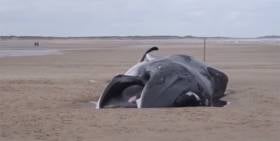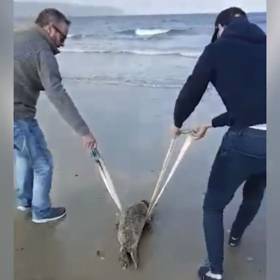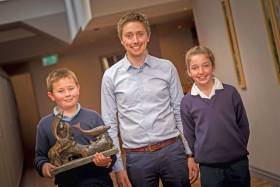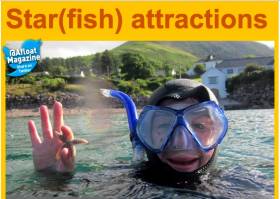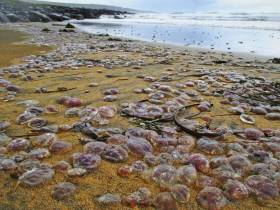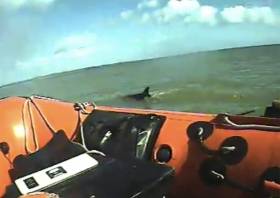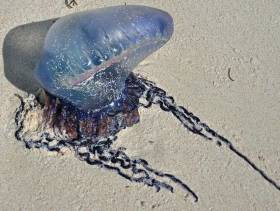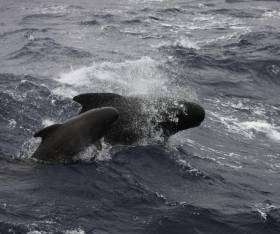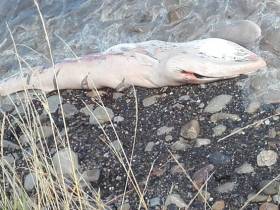Displaying items by tag: marine wildlife
Mystery Of Fin Whale Beaching On UK’s North Sea Coast
#MarineWildlife - Marine scientists have been puzzled by the recent beaching of a whale rarely seen off the east coast of England.
According to the Guardian, the carcass of a 12m fin whale washed up at Holkham in Norfolk last Thursday afternoon (20 October), far from its usual waters between Britain and Ireland.
“You never get them in the North Sea, so what it was doing there, we have no idea at the moment,” biologist Dr Ben Garrod told the newspaper.
It’s not yet known what causes the marine giant’s death, though collision with a vessel in the North Sea has been mooted as one possibility, as the Eastern Daily Press reports.
Beachgoers Rescue Seal Pup From Co Down Strand
#MarineWildlife - Independent.ie has video of a seal pup being rescued by quick-thinking beachgoers in Co Down this week.
Aaron McLoughlin realised he had no phone signal to call for assistance when he and his wife Gemma and her family found the young seal stranded on the sand.
So he and his father-in-law David Lamont improvised a sling to lift the juvenile marine mammal out of danger and back into the water, as you can see in the clip below:
Salmon Life Cycle Video Nets ‘Something Fishy’ Prize For Sligo Pupils
#SomethingFishy - Pupils at Scoil Chroí Naofa in Bunninadden, Sligo have been named the national winners of Inland Fisheries Ireland’s Something Fishy competition for 2016 at an event in Sligo’s Clarion Hotel yesterday (Wednesday 12 October).
The winning group of 24 children from the school’s senior class take home the National Something Fishy Award and €700 for their animated short on the life cycle of the salmon – selected by an independent judging panel comprising fisheries officers and education staff.
Along with their teacher Adrian Ormsby, the class edited and produced the digital and artistic photo story during the previous school term.
The ‘Something Fishy’ programme is an educational initiative of Inland Fisheries Ireland (IFI) in partnership with Blackrock Education Centre, which allows students to learn about fish and the environment in a local context.
The 2016 programme saw 3,776 children taking part in 118 schools and 11 education centres nationwide. Students were invited to submit project entries into the competition with this year’s entries addressing the theme ‘Focus on Learning’.
“The standard of entry to this year’s Something Fishy competition was particularly high and it is fantastic to have so many children engaged on our fisheries resource,” said IFI chief executive Dr Ciaran Byrne.
“Something Fishy gives children an opportunity to learn valuable lessons about the importance of protecting and conserving the aquatic environment but perhaps more importantly, they are also empowered to share their learnings with their peers via digital projects which can be enjoyed by all.”
Bernie Burke, principal of Scoil Chroí Naofa, described the win as “a fantastic achievement by the students involved who have thoroughly enjoyed taking part in the programme.
“They have discovered the magical world within our waterways and enjoyed learning all about the aquatic environment. I would like to congratulate each of them and their teacher Mr Ormsby on all their hard work.”
Since the inception of Something Fishy in 2005, some 50,000 children have participated in the initiative which aims to promote interest and understanding in fish and their habitats.
As part of the educational programme, IFI fisheries officers visit schools and provide classroom-based assistance, with a full range of resources for teachers and children also available on the Something Fishy website.
Together, they explore the themes of fish, habitats, angling, water environment and the protection and conservation of Ireland’s rivers and lakes.
Aside from school-based learning, fisheries officers take students into the field to give them some practical experience of their work.
Read Today's Irish Sailing & Boating E–News from Afloat.ie
Read Afloat's e–news below with all the latest sailing and boating highlights featuring: Star(fish) attractions: Why village sea centre & All-Ireland trail are shining bright; Txt for Spinal Injuries’ RIB; & save date for Ilen baa-rty
Sign up for a daily digest of Irish sailing and boating news direct to your email on our home page (bottom right).
|
Mauve Stinger Jellyfish Beach In Their Thousands On Co Clare Strand
#Jellyfish - Mauve jellyfish have stranded in what could be record numbers in Co Clare.
Thousands of the species Pelagia noctiluca, also known as the mauve stinger, have beached at Fanore since last Friday (30 September) as photographed by local man Liam McNamara.
"This is the first time I've experienced mauve jellyfish in such numbers and I've been beachcombing for 40 years,” McNamara told Independent.ie.
"I'm not sure what's going on with our seas but definitely lots more jellies around.”
The surprising incident comes just days after hundreds of Portuguese man o’ wars began stranding at coastal spots along the Wild Atlantic Way between Kerry and Donegal in what’s thought to be the largest infestation in over a century.
Irish Water Safety says unusually warm sea temperatures have brought what are typically tropical species in droves to Irish waters.
Ballycotton Lifeboat Launches To Stranded Dolphin
#RNLI - Ballycotton RNLI launched around 1pm yesterday afternoon (Thursday 29 September) to aid a dolphin stranded in shallow water on Silver Strand beach near the East Cork village.
A member of the public who was on scene had tried to assist the dolphin back to sea, but when they were unable to do so they alerted the Ballycotton lifeboat.
Ballycotton’s inshore lifeboat and its volunteer crew were quickly on scene, with the all-weather lifeboat on standby due to the offshore breeze and calm weather conditions.
Upon arrival, coxswain Eolan Walsh entered the water, guided the marine mammal into deeper water and shepherded it back out to sea.
Speaking after the callout, Walsh said: “Similar to a previous launch last summer, this dolphin appeared to be quite young and may have been separated from its pod.
“We would like to commend the member of the public who assisted the dolphin initially. We were happy to help and bring the dolphin into deeper waters.”
Portuguese Man O’ War Sightings Prompt Calls For Coastal Caution
#MarineWildlife - Sightings of the deadly Portuguese man o’ war along the West Coast have prompted calls for caution among coastal users, especially surfers and other beachgoers.
TheJournal.ie yesterday reported that as many as 15 of the toxic sea organisms that resemble jellyfish had been spotted on various beaches in Co Mayo and Co Clare.
Further sightings have been made along the Wild Atlantic Way as far south as Co Kerry and as far north as Donegal, according to The Irish Times, which carries Dr Tom Doyle’s warning for the public to steer clear of any specimens they might discover washed up on the shore.
The marine biologist with NUI Galway’s Ryan Institute emphasised that the creatures harbour seriously painful stings in their blue tentacles that have even killed three people worldwide.
Wexford Men Come To Rescue Of Beached Pilot Whale
#MarineWildlife - A young pilot whale was saved by a group of quick-thinking Wexford men after stranding on a beach at Kilmore Quay, as the New Ross Standard reports.
When Neil Bates spotted the 3m whale at Ballyteige Burrow and saw its blowhole move, he enlisted two other local men, John and Michael O'Flahery, to help refloat the animal.
And while it was it some distress for a time, it was soon out of the shallows and swimming in the direction of Hook Head.
In other marine wildlife news, the Irish Whale and Dolphin Group is seeking to recruit a new general manager, based out of the Shannon Dolphin Centre in Kilrush, Co Clare.
Ocean Warming Poses Threat To Marine Wildlife & Food Chain
#OceanWarming - Warming oceans are not only throwing marine ecosystems into disarray, but are also encouraging the spread of water-borne bacteria and viruses around the world, a new study warns.
The Irish Examiner reports on new findings from the International Union for Conservation of Nature (IUCN), which says the world is "completely unprepared" for the consequences of ocean warming, which have already been seen as fish and marine mammal species move into cooler northern waters.
Coming in their wake, however, are tropical pathogens such as Vibrio vulnificus, related to the cholera bacteria, and potentially toxic algal blooms that could enter the food chain – comprising what scientists are calling the "greatest hidden challenge of our generation".
Rising sea temperatures are already wreaking havoc on corals off East Africa in the Indian Ocean, and affecting the breeding success of seabirds, ocean reptiles, jellyfish and plankton – the foodstuff of large baleen whales and basking sharks, which frequent Irish shores.
The Irish Examiner has more on the story HERE.
Public Warned Away From Killiney Minke Whale Carcass
#MarineWildlife - Dun Laoghaire-Rathdown County Council has warned the public to stay away from the carcass of a minke whale that has washed up on Killiney Beach.
According to TheJournal.ie, the carcass of the 13m female minke whale was seen floating off Greystones yesterday and Shankill earlier today (Friday 19 August).
In what's an unusual occurrence for the East Coast, the carcass has washed up on a rocky stretch made even more treacherous by high spring tides – and it may also pose a risk of infection to curious beachgoers.
#dlrcc is aware of deceased 13m minke whale at #Killiney beach. Public asked to avoid location until further notice. pic.twitter.com/9Bvw6kQQhS
— dlrcc (@dlrcc) August 19, 2016


























